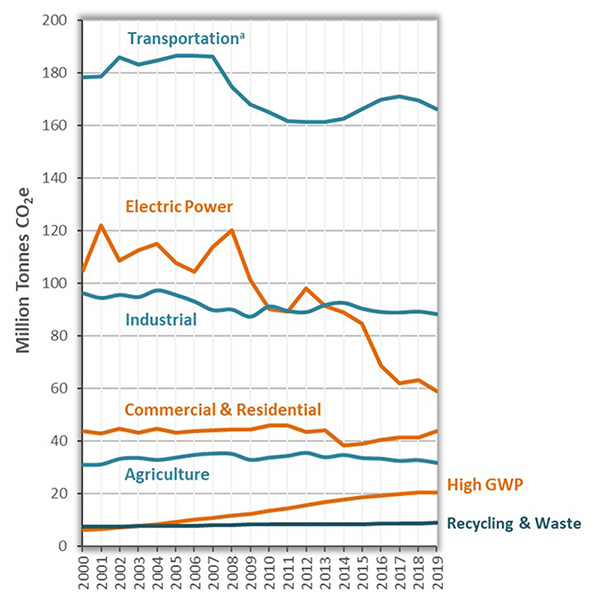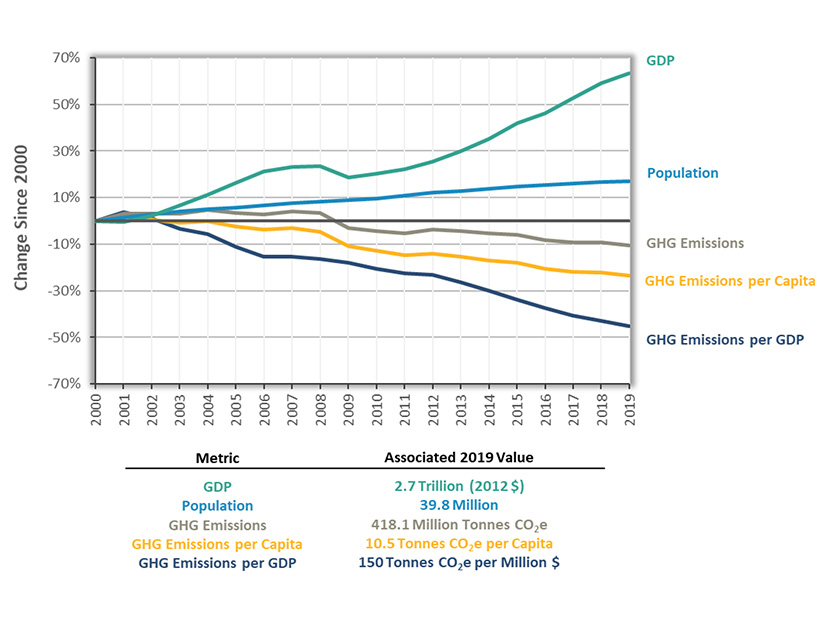Increased use of renewable diesel and greater availability of hydropower helped California cut its greenhouse gas emissions by 1.7% in 2019, according to a new report from the California Air Resources Board (CARB).
The 2019 decrease, which is a reduction of 7 million metric tons of CO2 equivalent, came after statewide GHG emissions essentially stayed flat in 2018, increasing by less than 1%.
California’s GHG emissions were 418.2 million metric tons of CO2 equivalent in 2019, 425.3 MMT in 2018, and 424.5 MMT in 2017. Statewide GHG emissions peaked in 2004 at around 490 MMT.
On a per capita basis, the state’s GHG emissions have dropped from a peak of 14.0 metric tons per person in 2001 to 10.5 metric tons per person in 2019, a 25% decrease. And as California’s gross domestic product grew by 63% from 2000 to 2019, the carbon intensity of California’s economy decreased by 45%, according to CARB.
The 2019 figures were released Wednesday in the latest edition of CARB’s annual greenhouse gas inventory.
GHG Reduction Targets
Under Assembly Bill 32, the California Global Warming Solutions Act of 2006, the state must reduce its GHG emissions to 1990 levels by 2020. The state reached that goal four years early, in 2016.
California’s Senate Bill 32 of 2016 set an even more ambitious target: reducing statewide GHG emissions to 40% below 1990 levels by 2030.
CARB Chairwoman Liane Randolph called the latest GHG inventory good news but noted that much larger GHG reductions will be needed to meet the 2030 goal.
“We are now once again witnessing massive wildfires and recurring heat waves while large parts of our state are suffering from extreme drought,” Randolph said in a news release. “This is a clear call to redouble our efforts.”
Analysis by Sector
CARB’s GHG inventory analyzes emissions by sector, including transportation, electric power, industrial, commercial and residential, and agriculture.
GHG emissions from the transportation sector, which accounts for 40% of the state’s inventory, fell in 2018 and in 2019. CARB said the 2019 reduction was due, in part, to a 61% increase in the use of renewable diesel fuel under the low-carbon fuel standard.

In the electric power sector, which accounts for 14% of the state’s GHG inventory, emissions have been falling since 2012, except for an uptick in 2018.
In 2019, California’s electric power emissions decreased by almost 7%, as 48% of total electricity generation came from solar, wind, hydropower and nuclear power, CARB said. The trend was boosted by a 46% increased availability of in-state hydropower in 2019.
Alex Jackson, a Sacramento-based senior attorney with the Natural Resources Defense Council, said CARB’s greenhouse gas inventory represents “impressive progress.” Still, he said, the state needs to redouble its efforts to reach its 2030 goal.
“I hope this is a call to arms,” Jackson said.
Jackson said the reductions in GHG emissions from transportation, which had long been a “stubborn sector,” were encouraging. The increasing adoption of electric vehicles should help continue that trend, he said.
But other sectors need more work, he said. For example, statewide emissions from the commercial and residential sector have been increasing, as have been emissions of high global warming potential gases, such as refrigerants.
“It is overall a mixed bag,” he said.
Emissions Counted Separately
CARB’s greenhouse gas inventory includes emissions from fossil fuel combustion, chemical reactions in industrial processes, use of GHG-containing consumer products and agricultural and waste sector operations.
CARB said it maintains a separate inventory for the exchange of ecosystem carbon between the atmosphere and plants and soils, including wildfire emissions.
The latest GHG inventory tracks the emissions of seven greenhouse gases covered by AB32: carbon dioxide, methane, nitrous oxide, hydrofluorocarbons, perfluorocarbons, sulfur hexafluoride and nitrogen trifluoride.
Other climate pollutants, including black carbon and sulfuryl fluoride, are monitored separately, CARB said in its report.
CARB said several programs that helped the state reach its 2020 GHG reduction target are increasing in stringency. Those include the renewables portfolio standard, the low-carbon fuel standard and the cap-and-trade regulation.
Other programs will reduce GHG emissions further, CARB said. These include rules to cut emissions from climate super pollutants such as hydrofluorocarbon refrigerants.
